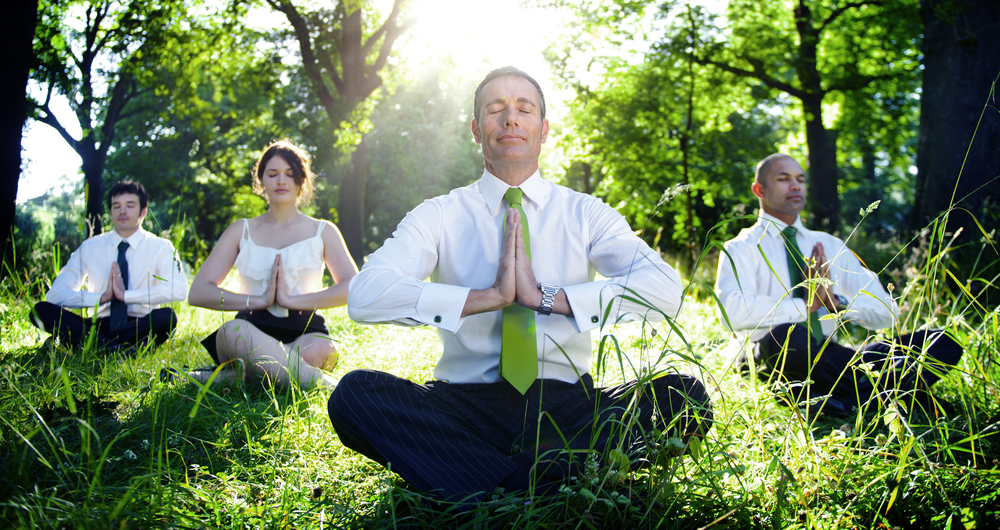A World War II-era British slogan has recently gained new popularity, advising us to “Keep calm and carry on.” But keeping calm isn’t easy lately. Many of us are juggling new responsibilities and that stress can lead to health issues, not to mention difficulty managing emotions. When we aren’t aware of how we are feeling it is easy to become irritated and push people away. Leaders need to be cognizant of their behavior, especially since staff members sometimes mimic them. Harsh interactions can put people on edge and make them afraid to come to you with bad news. And it can alienate clients and business associates.
Leaders who are centered and calm are aware of their emotions and behave with intention. There are many ways to be calm and centered. Try a few and pick the ones that work the best for you.
Meditation
Meditation can be approached in many ways but the simplest is just by becoming aware of your breath. As you breathe, say to yourself, “I am breathing in, I am breathing out” and notice where your breath is. If it is high in your chest that can lead to hyperventilating. Consciously taking a deep breath allows your breath to move down and calms you. Other ways of meditating include focusing on a candle flame, closing your eyes and letting your thoughts go, or participating in guided meditation that keeps your mind engaged for the sake of letting go. If you prefer having someone lead your meditation, look into meditation groups or a meditation app like Head Space.
Moving Meditation
Some people find it hard to sit still while meditating. Instead of being relaxed, they get antsy. If you’re one of these people, moving meditation can be calming. Try taking a walk and focus on your body: notice as you lift one leg and step consciously from your heel to the ball of your foot. Pay attention to each step until the rhythm occupies your subconscious. Observe your surroundings as if you were seeing them for the first time.
Mindfulness
Being present or mindful means paying full attention to what you are doing without distractions. Many of us do multiple things at once, like watching TV while cooking or cleaning. While multitasking can make us feel like we’re making an efficient use of time, research has shown that we’re not actually doing any of these tasks well. To practice mindfulness do one activity at a time, be it peeling a potato, weeding in the garden, grooming a pet, or eating a meal. As you immerse yourself fully in the activity, notice how it feels to turn yourself over to it.
 Somatic Practices
Somatic Practices
Studying with the Strozzi Institute I learned a number of exercises that helped me be centered and align my body, emotions, and spirit. Aikido, tai chi and other martial arts also increase body awareness and the connection to emotions. With continuous practice, the exercises become second nature, helping to keep you centered physically, mentally, and emotionally.
Children and Pets
Playing with young children encourages you to be in the present. And seeing the world through a child’s eyes can bring wonder and a greater appreciation for things we may have been taking for granted.
There’s mounting evidence that companion animals — cats, dogs, rabbits, horses — help us reduce stress. One study found petting a dog for just 15 minutes can lower blood pressure by 10 percent. Spending quality time with pets reduces the stress hormone cortisol in our bodies while increasing mood-stabilizing hormones like serotonin, oxytocin, and prolactin, according to research findings.
Hobbies
A hobby that fully engages you is like an emotional sanctuary. It can be gardening, painting, woodworking, golf, home repair, house decorating, photography, cooking, crafts — anything that brings you peace. I love to organize and get great pleasure from cleaning a closet or drawer. However, even the most joyful activity can be ruined if you invite your inner critic to join you. Think about how children create with pure joy and little awareness of “perfection.” If you find yourself becoming angry or frustrated with your hobby, try approaching it with a beginner’s mind. Or find a new hobby.
Exercise
 Exercise is a wonderful way to release pent up emotions and to bring vitality to your mind and body. As with hobbies, choose an activity that brings you pleasure, whether it’s running, walking, hiking, dancing, swimming, yoga, Pilates, or any of a myriad of sports. As you try different activities notice whether you get more pleasure exercising alone or with others. And be mindful that the goal is not to push yourself but rather to find calm within yourself.
Exercise is a wonderful way to release pent up emotions and to bring vitality to your mind and body. As with hobbies, choose an activity that brings you pleasure, whether it’s running, walking, hiking, dancing, swimming, yoga, Pilates, or any of a myriad of sports. As you try different activities notice whether you get more pleasure exercising alone or with others. And be mindful that the goal is not to push yourself but rather to find calm within yourself.
Sleep
Sleep is restorative and deep sleep allows you to function better, boosting your immune system, strengthening your heart, and elevating your mood. There are many ways to improve “sleep hygiene,” such as not eating a heavy meal before bed, reducing screen time late in the day, and avoiding alcohol and caffeine. All the activities listed above can improve your sleep.
To be the best leader you can be, find ways to reduce your stress, keep calm and carry on. The best activities are self-reinforcing; you’ll keep doing them because they’re pleasurable and are easy to make part of your routine.

